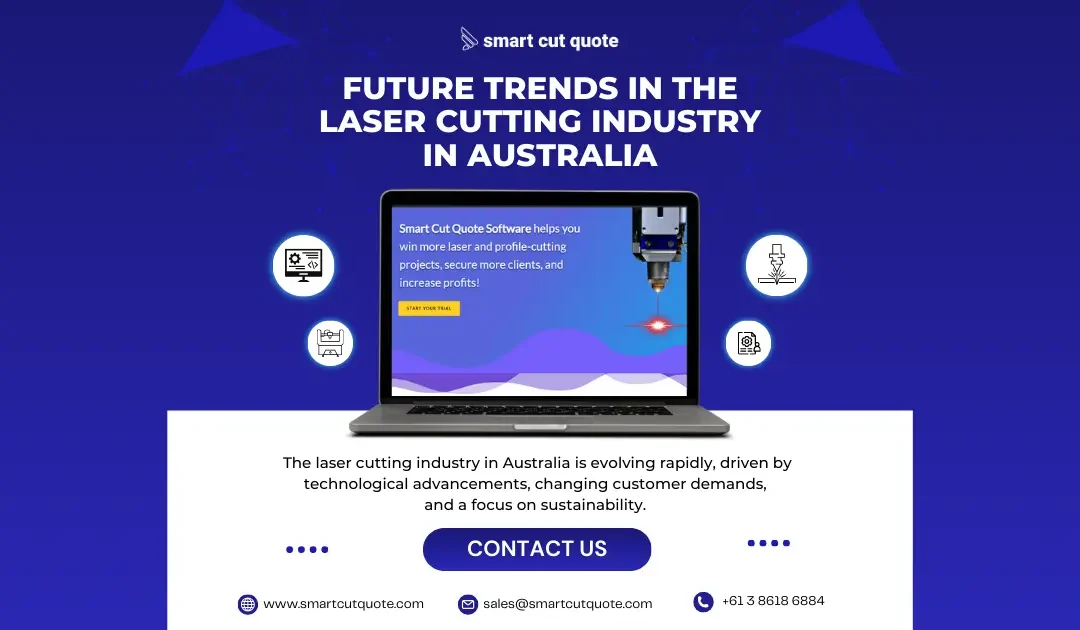Future Trends in the Laser Cutting Industry in Australia
The laser cutting industry in Australia is evolving rapidly, driven by technological advancements, changing customer demands, and a focus on sustainability. These trends are shaping the future of the industry, offering both challenges and opportunities for manufacturers, job shops, and service providers.
Adoption of Fibre Laser Technology
Fibre laser technology is becoming the industry standard, replacing traditional CO₂ lasers due to its numerous advantages:
- Efficiency Gains – Fibre lasers offer faster cutting speeds, lower maintenance needs, and improved energy efficiency.
- Versatility – These machines can handle both thin and thick materials, making them adaptable to various industries.
- Lower Operating Costs – Reduced power consumption and longer-lasting components make fibre lasers a cost-effective choice.
Integration of Industry 4.0 and IoT
The rise of smart manufacturing is transforming laser cutting operations through digital connectivity and automation:
- Smart Manufacturing: IoT-enabled laser cutting machines can monitor performance in real-time, predict maintenance needs, and reduce downtime.
- Data-Driven Decisions – Integration with Manufacturing Execution Systems (MES) and Enterprise Resource Planning (ERP) improves workflow optimisation and resource allocation.
- Customisation at Scale – Digital twins and advanced simulations enable the efficient production of customised parts.
Automation in Laser Cutting
Automation is reducing manual labour while enhancing productivity and precision:
- Robotic Assistance: Robotic arms are increasingly being used for loading and unloading materials, reducing manual labour and improving safety.
- Automated Nesting: Advanced nesting software like MAXXCAM optimises material usage, furthering automation in pre-production processes.
- Unmanned Operations: Fully automated laser cutting systems enable continuous operation, improving productivity during off-hours.
Sustainability and Eco-Friendly Practices
As Australia pushes towards greener industries, sustainability in laser cutting is gaining traction:
- Waste Reduction: Efficient nesting software and material management systems minimise scrap and optimise sheet utilisation.
- Energy Efficiency: Modern laser cutting machines are designed to consume less energy, aligning with Australia’s push for greener industries.
- Recycling Initiatives: Increased emphasis on recycling and reusing materials to reduce the environmental impact of manufacturing.
Expansion of Applications
Laser cutting is finding new applications across emerging industries:
- Emerging Industries: The growth of industries like renewable energy, aerospace, and medical device manufacturing is increasing demand for precision laser cutting.
- 3D Laser Cutting: Adoption of 3D laser cutting technologies allows manufacturers to handle complex geometries and multi-dimensional parts.
- Additive Manufacturing Integration: Combining laser cutting with 3D printing technologies offers new possibilities in hybrid manufacturing.
Advanced Software Solutions
Innovative software is improving efficiency, cost estimation, and production planning:
- Comprehensive Solutions: Tools like Smart Cut Quote streamline quoting, material management, and cost estimation, enabling competitive pricing and faster turnaround.
- Cloud-Based Platforms: Cloud integration allows for remote monitoring, collaboration, and scalability in operations.
- AI-Powered Nesting: Artificial intelligence is being integrated into nesting software to further optimise layouts and reduce manual intervention.
Increasing Focus on Customisation
Customisation is becoming a key differentiator in the laser cutting industry:
- Customer-Centric Production: The ability to handle small batch runs and customised designs is becoming a critical differentiator for laser cutting businesses.
- Flexible Manufacturing Systems: Investments in modular and adaptable systems allow manufacturers to cater to diverse client needs efficiently.
Workforce Upskilling
The adoption of advanced technologies is driving demand for skilled professionals:
- Training for Advanced Machinery: With the adoption of new technologies, there is a growing demand for skilled operators and programmers familiar with modern laser cutting systems.
- Digital Proficiency: Training in CAD/CAM software, IoT integration, and data analysis is becoming a standard requirement for industry professionals.
Localisation of Manufacturing
Manufacturers are increasingly looking to source and produce locally due to global economic shifts:
- Shorter Supply Chains: Growing geopolitical concerns and rising transportation costs are pushing Australian manufacturers to source and produce locally.
- Government Support: Incentives and grants for local manufacturers are encouraging investments in laser cutting and related technologies.
Enhanced Focus on Quality and Precision
As high-tech industries grow, precision requirements are becoming more stringent:
- Tighter Tolerances: As industries like aerospace and medical grow, the demand for ultra-precise laser cutting increases.
- Advanced Materials: Growth in materials like composites and high-strength alloys requires innovative laser cutting techniques.
The future of laser cutting in Australia is being shaped by advancements in technology, automation, and sustainability. Companies that invest in cutting-edge machinery, embrace digital transformation, and prioritise eco-friendly practices will be well-positioned to thrive. By staying ahead of these trends, manufacturers can meet evolving market demands and secure their place in a competitive and innovative industry.
For more information about Smart cut Quote Software and product inquiries, please contact us at https://nctools.com.au/ or call us on +61 3 8618 6884
Or Visit https://smartcutquote.com/

